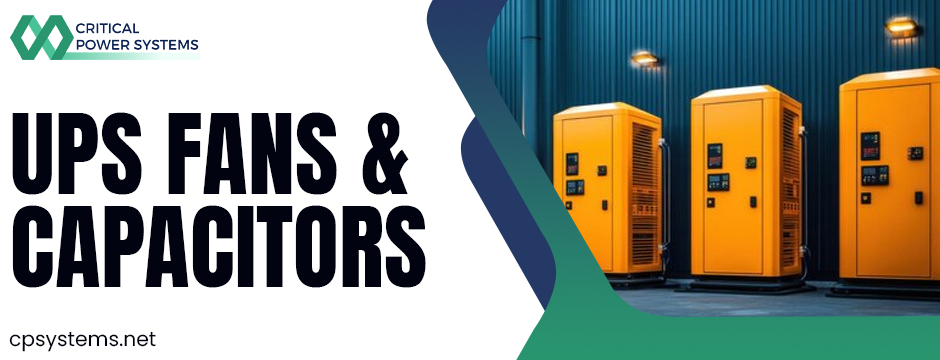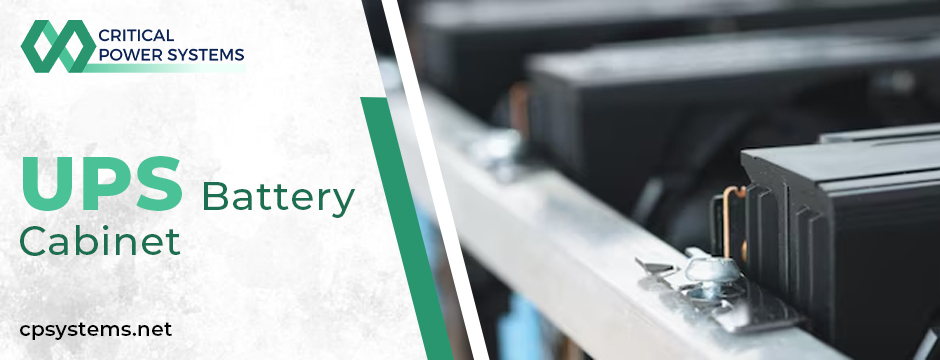Let’s face it—power outages don’t come with a warning. Whether it’s a sudden storm, a grid failure, or equipment malfunction, losing power can disrupt everything. For many businesses, even a few seconds offline can cause serious headaches: data loss, missed transactions, or worse—complete operational shutdown.
That’s where UPS battery cabinet quietly step in and save the day. These aren’t just metal boxes with batteries. They’re the unsung heroes sitting behind your equipment, making sure your operations don’t skip a beat when the lights go out.
At Critical Power Systems, we’ve spent years helping companies across industries protect their infrastructure with reliable power solutions. Let’s walk you through what a UPS battery cabinet is, why it matters, and how it fits into the bigger picture of uninterrupted business.

So, What Exactly Is a UPS Battery Cabinet?
Think of a UPS battery cabinet as your backup fuel tank—but for electricity. It’s an external enclosure that holds batteries connected to your Uninterruptible Power Supply (UPS) system. When the power fails, these batteries take over instantly to keep your systems running.
But here’s the thing: it’s not just about “keeping the lights on.” It’s about buying you time—whether it’s a few minutes to safely shut things down or a few hours until your generator kicks in.
Depending on your setup, a battery cabinet can dramatically extend the runtime of your UPS system. And that time can mean everything when you’re running a data center, a hospital wing, or even a single server that can’t afford to go dark.
What’s Actually Inside the Cabinet?
No, it’s not magic. But it’s pretty close.
Inside a UPS battery cabinet, you’ll typically find:
- Rows of sealed lead-acid or lithium-ion batteries
- Heavy-duty cabling and connections
- Internal cooling fans
- Monitoring equipment to track battery performance
- Circuit breakers or fuses for safety
Some more advanced setups also integrate UPS capacitors and fans, especially in larger installations where thermal regulation and current flow need to be rock solid.
It’s built to do one thing exceptionally well: deliver consistent, reliable power in moments when everything else fails.
Why It’s Not Just “Nice to Have”—It’s Essential
If you’ve ever lost work from a laptop crash, imagine what an unplanned power outage does to an entire business network. That’s why UPS battery cabinet are so critical—they prevent loss, downtime, and damage.
Here’s what makes them invaluable:
1. Immediate Response
The moment power drops, the batteries inside the cabinet kick in—no delay, no lag. That seamless switchover is what keeps your systems running and avoids costly interruptions.
2. Extended Runtime
A UPS on its own might only give you a few minutes of backup. Add a battery cabinet, and that time multiplies. You can go from a 5-minute buffer to an hour or more, depending on your load and configuration.
3. Protection for Sensitive Equipment
Voltage drops and surges can fry hardware. Battery cabinets deliver stable, clean power, shielding your systems from sudden electrical shocks that damage delicate components.
4. Scalability
As your operations grow, so can your backup. Many setups allow you to stack or link multiple cabinets together. That means you don’t have to overhaul your entire system every time your needs change.
UPS Fans & Capacitors: The Quiet MVPs
Now, here’s a part most people overlook—UPS fans and capacitors. They don’t get much spotlight, but without them, the whole system can fall apart.
- Fans regulate temperature. Batteries hate heat. A well-ventilated battery cabinet keeps your system from overheating, which can significantly extend battery life.
- Capacitors stabilize power flow. They smooth out any ripples or spikes in current, ensuring your equipment gets exactly what it needs without any fluctuations.
At Critical Power Systems, we always recommend inspecting and replacing worn-out fans or capacitors before they become a problem. It’s one of those little things that can save you a fortune in the long run.
Real-World Use Cases: Where These Cabinets Really Shine
UPS battery cabinet aren’t just for big-name data centers or mega-corporations. We’ve seen them make a difference in places like:
- Hospitals, where life-saving machines can’t risk a power blip
- Factories, where a second of downtime can shut down entire production lines
- Retail stores, where registers and card machines rely on steady power
- Schools, keeping servers online for virtual learning platforms
- Financial institutions, where data integrity is non-negotiable
Basically, if your business can’t afford downtime, you need to think seriously about your backup power setup—and that includes a UPS battery cabinet.
Buying Guide: How to Choose the Right One
Every business has different needs. Choosing the right UPS battery cabinet isn’t one-size-fits-all. Here’s what you should consider before making a move:
- Runtime Requirements: How long do you need to stay powered during an outage?
- Load Capacity: What equipment are you backing up? A few computers or an entire server room?
- Physical Space: Battery cabinets vary in size. Know how much room you have.
- Battery Type: Lead-acid is common, but lithium-ion is gaining traction for its longevity and compact size.
- Maintenance Access: Go for a design that makes it easy to test, replace, or service your batteries.
Still unsure? That’s where we come in. Our team at Critical Power Systems will walk you through your options and help you build a setup that’s reliable, scalable, and tailored to your business.

Maintenance: Don’t Set It and Forget It
Even the best battery cabinet needs care. Here are a few simple things you can do to keep it running like clockwork:
- Run regular battery tests—don’t wait for an outage to find out something’s wrong
- Inspect for corrosion or swelling every few months
- Keep an eye on temperature, especially in warmer climates
- Replace fans and capacitors every 3–5 years (they wear out silently)
We also offer preventative maintenance plans, so you’re never caught off guard.
Why Choose Critical Power Systems?
Here’s the truth: battery cabinets are easy to overlook—until they fail.
At Critical Power Systems, we’re passionate about making sure that never happens to you. We don’t just sell products; we offer peace of mind. Our solutions are built tough, installed by pros, and backed by real-world expertise.
You won’t find off-the-shelf answers here. We dig deep to understand your business, your power load, and your risk tolerance—then we design something that fits like a glove.
Final Thoughts
Power outages are unpredictable. Your response shouldn’t be.
A UPS battery cabinet is one of the smartest investments you can make to protect your business from downtime, data loss, and damage. It’s not just about backup—it’s about being ready when everything else fails.
Need help figuring out where to start? We’ve got your back. Reach out to Critical Power Systems, and let’s build a power protection plan that never lets you down.
Speak to a UPS Specialist Today
Don’t leave your backup power to chance. Contact us at Critical Power Systems for a free consultation and site evaluation.
FAQs –
Q1. What exactly does a UPS battery cabinet do?
A UPS battery cabinet holds batteries that provide backup power to your systems when the main electricity source goes down. It works with your UPS unit to keep critical equipment running during outages, preventing sudden shutdowns and data loss.
Q2. How long will a UPS battery cabinet keep my systems running?
That depends on the size of your battery cabinet and how much equipment it’s supporting. Some setups provide just a few minutes of power, while others can keep systems online for several hours.
Q3. Do I need a UPS battery cabinet if I already have a UPS unit?
If your current UPS system has limited runtime or your operations are growing, a battery cabinet can give you more runtime and greater flexibility. It’s ideal for businesses that can’t afford downtime, even for a minute.
Q4. What type of batteries are used in a UPS battery cabinet?
Most battery cabinets use sealed lead-acid (VRLA) or lithium-ion batteries. VRLA is more common due to cost, but lithium-ion is gaining popularity for its longer lifespan and compact size.
Q5. How often should I replace batteries in a UPS cabinet?
On average, batteries need replacement every 3–5 years. Factors like usage, temperature, and maintenance frequency can impact battery life. Regular inspections are key.

